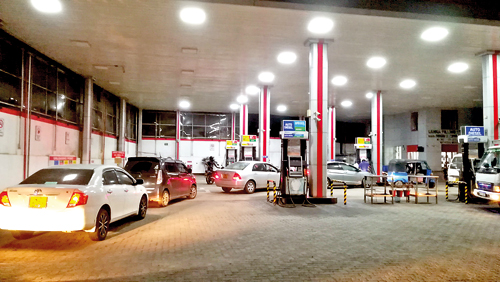Calculation of Sri Lankan fuel prices and why they are so high

Cars at a petrol station soon after the increase in fuel prices was announced
In the wake of confusion triggered with the increase in fuel price after maintaining it at a stable level for 20 months, the new pricing policy adopted by the government has triggered a cost of living crisis, economists and analysts said.
They said people should be made aware of the reason for the increase of the price of a litre of Petrol 92 Octane by Rs.20 to Rs.157, Petrol 95 Octane by Rs.23 to Rs.184, Auto Diesel by Rs.7 to Rs.111, Super Diesel by Rs.12 to Rs.144 and Kerosene oil by Rs.7 to Rs.77.
Though complex in nature, it is essential to divulge the method of calculation to increase or decrease prices and the actual amount of taxes imposed on fuel along with the profit or loss incurred by the Ceylon Petroleum Corporation (CPC), economists said.
It was for the first time ever that the previous regime publicly announced a fuel pricing formula under the directions of the then Finance Minister Mangala Smaraweera.
The Finance Ministry had announced a cost reflective price formula for fuel in 2018 under the supervision of former Treasury secretary Dr. R.H.S. Samarathunga.
The pricing formula was reportedly said to be constructed by a technical committee based on landed cost, processing cost, administrative cost, and taxation. The formula read as “maximum retail price (MRP) = V1+V2+V3+V4”.
However according to Treasury sources, the fuel price formula introduced by the previous Government was nothing new at all and it is same up to date. Only the tax components were changed in the formula whenever there was a tax revision, an official explained, adding that the method of calculation is little bit complicated and it was made simple for the people to understand.
In this mathematical model, only the importation of refined petroleum products cost was considered and has not taken into account the refining of crude oil in Sri Lanka cost.
The responsibility of the Finance Ministry was to combine refined oil and crude oil importation costs along with refining cost as two functions to obtain a final fuel price which reflects both the scenarios and represents the concerns of stake holders, market and regulatory bodies.
Accordingly, V1 – the landed cost, includes Singapore Platts price per barrel, weighted average premium per barrel, losses due to the evaporation, and losses due to the exchange rate.
V2 – the processing cost, includes local port charges, transport cost, dealers’ margin including losses due to evaporation, and stock holding cost.
V3 – the administrative cost, includes expenses including personnel cost, depreciation, and other cost elements, if there are any. The last component, V4 – refers to taxation. It includes customs import duty, excise duty, ports and airports development levy, and nation building tax.
This was the simplest format of the formula announced by the finance ministry at that time so that people can calculate the fuel price and make any comparison with the previous price, the official said.


